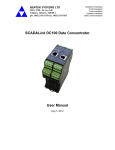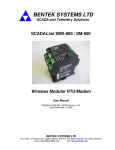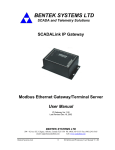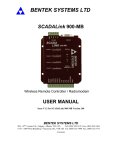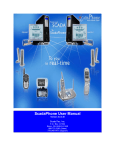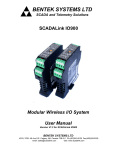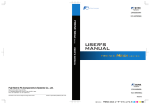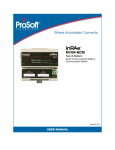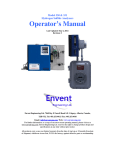Download SCADALink User Manual
Transcript
BENTEK SYSTEMS LTD #315, 3750 - 46 Ave S.E. Calgary, Alberta, T2B 0L1 ph: (403) 243-5135 fax: (403) 243-5165 SCADA & Telemetry Control Systems Instrumentation Operator Interfaces Data Communications SCADALink SCADASwitch SS10 Multiplexer / RS-232 Switch User Manual Feb 15, 2012 www.scadalink.com TABLE OF CONTENTS 1 GENERAL OVERVIEW ............................................................................................. 1 2 HARDWARE OVERVIEW ........................................................................................ 2 2.1. HARDWARE ...................................................................................................... 2 2.2 SPECIFICATIONS ............................................................................................ 3 3 CONFIGURATION .................................................................................................... 6 3.1 SETTING UP HYPERTERMINAL ................................................................... 6 3.2 SETTING SCADASwitch CONFIGURATION SETTING .......................... 6 3.2.1 General........................................................................................................ 6 3.2.2 Settings ........................................................................................................ 7 4 TYPICAL OPERATING MODES ........................................................................... 10 4.1 Mux MODE ......................................................................................................... 10 4.2 LOI / RS-232 SWITCH MODE .................................................................... 10 4.3 Modbus ADDRESS TRANSLATION MODE .............................................. 11 4.4 Modbus WRITE BLOCKING MODE ............................................................ 11 4.5 RS-232 RADIO KEYING MODE .................................................................. 12 4.6 RS232 / RS485 CONVERSION MODE ..................................................... 12 APPENDIX A – UPGRADE FIRMWARE ................................................................. 13 SCADASwitch SS10 User Manual 1 GENERAL OVERVIEW This document summarizes the operation and configuration of the SCADASwitch SS10. A soft copy of this manual can be found at www.scadalink.com. The SCADASwitch is a low cost, compact data communications interface device designed for a range of SCADA & Industrial control applications. The SCADASwitch has two RS232 input ports and an output port that simultaneously supports both RS-232 and RS-485 connections to give it a flexible range of functions. It can be configured via terminal software to do the following: • • • • • • • Multiplexing – Allows 2 Master devices to share a single communication channel (Note: only works for Poll/Response-type protocols such as Modbus or ROC). LOI / RS-232 Switch - (Local Operator Interface Mode) - Allows a configuration computer to connect to RTU/EFM device(s) without the need to physically disconnect the SCADA Host Modbus Address Translation - SS10 can translate the address of an incoming Modbus message to any other valid Modbus address. Address translation can be configured on both input ports independently. This allows 2 different networks to connect to the same slave device on two different addresses. Modbus Register Write Blocking – By blocking Modbus Writes to PLC/RTU/EFM from a specific Input Port, this feature can be used to grant ReadOnly access to one SCADA host while allowing full access to a second host. RS-232 Radio Keying – Allows an RTU with no handshaking signals to key a radio that requires RTS. RS-485 Conversion - Converts RS-232 to RS-485 Custom Protocol Conversion – Upon special request, Bentek Systems can develop custom protocol conversion firmware for SCADASwitch (i.e. to enable Modbus protocol for specialized devices) With low power draw, small size, DIN rail mounting, and Class I Div 2 rating, the SS10 is ideal for use in remote EFM/RTU applications. Feb 15, 2012 General Overview 1 of 13 SCADASwitch SS10 User Manual 2 HARDWARE OVERVIEW 2.1. HARDWARE The SS10 is shown in Figure 1 below: COM 1 COM 2 COM 3: RS-232 COM 3: RS-485 Input Power Switched Power Output LEDs Figure 1: SS10 Hardware Table 1: Connectors CONNECTOR Input Power Switched Power Output COM1 Tx, Rx, GND COM2 Tx, Rx, GND, RTS, CTS COM3: RS-232 Tx, Rx, GND, RTS, CTS COM3: RS-485 Tx+, Tx-, Rx+, Rx-, GND Feb 15, 2012 PINS PWR, GND SWP, GND DESCRIPTION 9-30VDC,Reverse Polarity Protection Vin-0.5V@ 2.5A peak or 1.5A continuous RS-232, DB9F (DCE) Used for Configuration and LOI or second Host for Multiplexing RS-232, 5 Pin Terminal Block, usually used for Primary Modem or SCADA input RS-232 Output, 5 Pin Terminal Block, usually used for slave connection or radio network RS-485 Output, 5 Pin Terminal Block, usually used to connect to slave devices or multidrop networks Hardware Overview 2 of 13 SCADASwitch SS10 User Manual Table 2: LEDs LEDS STATUS Tx Rx DESCRIPTION 1. Flashes every second while waiting for Entry to Configure Mode 2. Off in Run Mode when Switched Power is off 3. Solidly lit when Switched Power Output is active 4. Solidly lit when in Configure Mode Flashes when there is data coming from COM3 Flashes when there is data going to COM3 2.2 SPECIFICATIONS Table 3: Hardware Specifications Feb 15, 2012 Hardware Overview 3 of 13 SCADASwitch SS10 User Manual Figure 2: Serial Port Signal Flow Direction Feb 15, 2012 Hardware Overview 4 of 13 SCADASwitch SS10 User Manual Figure 3: COM 3 RS-485 Wiring Feb 15, 2012 Hardware Overview 5 of 13 SCADASwitch SS10 User Manual 3 CONFIGURATION The SCADASwitch is configured with a terminal program such as Hyperterminal and connected with a standard straight thru RS-232 cable DB9 Female to DB9 Male to SS10 COM 1. 3.1 SETTING UP HYPERTERMINAL 1. Connect the PC COM Port to the SCADASwitch COM1: via straight thru cable and run Hyperterminal. 2. Start up Hyperterminal and set to 9600 N 8 1 (9600 Baud, No Parity, 8 Data Bit, 1 Stop Bit No Handshaking). 3. Cycle power to the SCADASwitch 4. After the SCADASwitch is rebooted, type <ESC> twice within 8 seconds to enter CONFIGURE mode. If successful, the SCADASwitch Configuration Menu will appear. If not, re-cycle the power and try again. NOTE: If no keys are pressed, SCADASwitch will automatically enter RUN mode after 8 seconds. 3.2 SETTING SCADASwitch CONFIGURATION SETTING 3.2.1 General Once you have successfully entered CONFIGURE mode, the Configuration Screen will appear. Feb 15, 2012 Configuration 6 of 13 SCADASwitch SS10 User Manual Figure 4: Configuration Screen 3.2.2 Settings 1-3: Serial Port Parameters Multiplex (Mux) Mode: (default mode) Both Input ports (COM1 & COM2) are able to communicate to devices connected to the Output Port (COM3). Requests from the input ports are sent on a first come first served basis and messages waiting to be sent are buffered internally until output port is available. Mux mode is used to transparently share a single serial port between two master devices. Local Operator Interface (LOI) Mode: COM2 is used as normal communications port to end devices connected to COM3 (Output port). COM1 is left unconnected and is used for Local interfacing to end devices. The SS10 automatically detects the connection of a RS232 device (eg. Laptop) on COM1 and blocks all traffic from COM2 until the cable is disconnected from the device on COM1. This mode is used to allow the operator to connect directly to the end devices on COM3 for local configuration, calibration etc. without being disrupted by traffic from COM2. Baud Rate and Data Format: All three com ports can be configured to have independent baud rates from 1200115200 baud. SS10 will automatically handle baud rate conversion between ports set to different rates. (default baud rate = 9600). Feb 15, 2012 Configuration 7 of 13 SCADASwitch SS10 User Manual All three com ports can also be configured with independent data formats. SS10 will automatically handle data format conversion between ports set to different data formats. (default = N:8:1) Supported settings are: -None, even, or odd Parity. -8 or 9 Data bits. -1 or 2 stop bits. Handshaking: (default = none) RTS or RTS/CTS handshaking are available on COM2 and COM3. When handshaking is enabled user will be prompted to enter a “RTS Delay” value. Handshaking operation is as follows: -RTS: When data is ready to be sent out via port in which RTS handshaking is enabled, RTS line is driven high. After the time specified by “RTS Delay” value, Message data is sent. After message has completed RTS line is driven low. -RTS/CTS: When data is ready to be sent out via port in which RTS/CTS handshaking is enabled, RTS line is driven high. SS10 waits for CTS to be asserted by the connected device. Once CTS signal is received the SS10 waits for the value of “RTS Delay” before sending message data. After message has completed RTS line is driven low. No Response Timeout: (default = 2000ms) COM3 (Output Port) configuration requires a “No Response Timeout” value. This value is the amount of time the SS10 will wait for a response from a device connected to COM3 before giving up and allowing the next request to be sent. This value should be set longer than the maximum expected response time from the end devices connected to COM3. NOTE: In Mux mode, the no response timeout values on both hosts should be set to “at least” twice the value set on the SS10. 4. Timer Options: The SS10 has a built in general purpose timer which controls the switched power output (SWP) on the two terminal block next to the power input. The timer can be programmed to turn on at a specified interval for a specified amount of time (in minutes) The SWP output sources power and can provide up to 2.5A peak, or 1.5A continuous. The Timer can be used to turn on a sensor or device for a limited amount of time in order to save power. 5-6. Modbus Write Protection: Both Input ports (COM1 & COM2) can be independently configured to block modbus write commands. When Enabled the SS10 will block all write commands to both holding registers and coil registers incoming on that port. When write protection is enabled, user can configure up to six ranges of register addresses (6 holding ranges and 6 coil ranges) in which write commands can be allowed if required, all other writes to any other registers except those ranges specified are blocked. In some cases a write might be necessary in order to populate an index for Feb 15, 2012 Configuration 8 of 13 SCADASwitch SS10 User Manual historical data polling (eg. Enron Modbus) This feature allows the user to configure the device so that the host device can still poll historical data but does not have write access to the rest of the device registers. 7-8: Modbus Address Translation / Blocking: Both Input ports (COM1 & COM2) can be independently configured to Translate, Pass, or Block any message containing a user specified modbus addresses within the valid range of 1-256. When translating the SS10 can convert incoming messages for one address and send them out for another address, then convert the response back to the original address. The SS10 can also block or pass specific addresses. The user can choose to either block or pass all other addresses not specified in the table. 9: Advanced Settings: These settings are for specific applications. Consult with Bentek Systems Ltd. before adjusting these settings. 10. Return to Factory Defaults: This option resets all configuration parameters to Factory Defaults. All current configuration settings are cleared. 11. Firmware upgrade: This Option is used to upgrade the current firmware running on the SS10. All current configuration settings are cleared. (See Appendix) 12. Save and Exit: Entering this option or pressing esc from the main menu screen exits the configuration mode and automatically reboots the SS10. Feb 15, 2012 Configuration 9 of 13 SCADASwitch SS10 User Manual 4 TYPICAL OPERATING MODES These are examples of some common modes that the SCADASwitch can be used in. 4.1 Mux MODE Figure 5: Modbus Multiplex Mode 4.2 LOI / RS-232 SWITCH MODE Feb 15, 2012 Typical Operating Modes 10 of 13 SCADASwitch SS10 User Manual Figure 6: Local Operator Interface Mode 4.3 Modbus ADDRESS TRANSLATION MODE Figure 7: Modbus Address Translation Mode 4.4 Modbus WRITE BLOCKING MODE Figure 8: Modbus Write Blocking Mode Feb 15, 2012 Typical Operating Modes 11 of 13 SCADASwitch SS10 User Manual 4.5 RS-232 RADIO KEYING MODE Figure 9: RS-232 Radio Keying Mode 4.6 RS232 / RS485 CONVERSION MODE Figure 10: RS-232 / RS-485 Conversion Mode Feb 15, 2012 Typical Operating Modes 12 of 13 SCADASwitch SS10 User Manual APPENDIX A – UPGRADE FIRMWARE The SS10 factory ships with the latest firmware. Under normal conditions, the firmware does not need to be upgraded. In the event that Bentek System issues a critical update to the firmware, or customizes it for your application, follow these instructions to upgrade. If you have problems upgrading, contact Bentek Systems at www.scadalink.com or [email protected] 1. Open Hyperterminal, set to COM1, 9600 Baud, No Parity, One Stop Bit, Hardware Flow Control. 2. Connect a standard straight-thru serial cable ( at least 5 wire: Tx, Rx, RTS, CTS, GND) from computer to DB9 port. 3. Connect 10-30VDC to SCADASwitch Input Power terminals 4. Cycle power on 5. While status light is flashing hit ESC twice within 8 seconds 6. If main menu appears, select Option 11, Upgrade Firmware, otherwise repeat steps 4 & 5 7. Wait for prompt “Erase complete, press any key” 8. Press any key ONCE 9. When prompted with the message “waiting for program…” Click transfer from the top menu bar and select “Send Text File” 9. Browse for the SCADASwitch Firmware file and select it 10. Spade characters will appear until file is finished loading. If no Spade characters appear, cycle power and start process again. 11. Cycle power Table 4: Programming Cable Pinout Signal Name Rx Tx Gnd RTS CTS Feb 15, 2012 DB9F Pin 2 3 5 7 8 Appendix A DB9M Pin 2 3 5 7 8 13 of 13















